Wind Tunnel Test on Windblown Sand Two-Phase Flow Characteristics in Arid Desert Regions
Abstract
1. Introduction
2. Experimental Apparatus, Methods and Design
2.1. Wind Tunnel Test
2.2. Field Measurement
3. Experimental Results and Discussion
3.1. Wind Tunnel Simulation of the Measured Impurity-Free Wind Flow Field
3.2. Movement Form of Sand Particles in the Windblown Sand Flow Field
3.3. Sand Concentration and Sand Transport Rate in the Windblown Sand Flow Field
3.4. Wind Profile in the Windblown Sand Flow Field
3.5. Turbulence Intensity in the Windblown Sand Flow Field
3.6. Energy Distribution of Sand Particles in the Windblown Sand Flow Field
3.7. Impact Pressure of Sand Particles in the Windblown Sand Flow Field
4. Conclusions
Author Contributions
Funding
Institutional Review Board Statement
Informed Consent Statement
Data Availability Statement
Conflicts of Interest
References
- Dong, Z.B.; Chen, G.T.; He, X.D.; Han, Z.W.; Wang, X.M. Controlling blown sand along the highway crossing the Taklimakan Desert. J. Arid Environ. 2004, 57, 329–344. [Google Scholar] [CrossRef]
- Yao, Z.Y.; Xiao, J.H.; Jiang, F.Q. Characteristics of daily extreme-wind gusts along the Lanxin Railway in Xinjiang, China. Aeolian Res. 2012, 6, 31–40. [Google Scholar] [CrossRef]
- Cheng, J.-J.; Xue, C.-X. The sand-damage-prevention engineering system for the railway in the desert region of the Qinghai-Tibet plateau. J. Wind Eng. Ind. Aerodyn. 2014, 125, 30–37. [Google Scholar] [CrossRef]
- Cheng, J.-J.; Jiang, F.-Q.; Xue, C.-X.; Xin, G.-W.; Li, K.-C.; Yang, Y.-H. Characteristics of the disastrous wind-sand environment along railways in the Gobi area of Xinjiang, China. Atmos. Environ. 2015, 102, 344–354. [Google Scholar] [CrossRef]
- Bruno, L.; Horvat, M.; Raffaele, L. Windblown sand along railway infrastructures: A review of challenges and mitigation measures. J. Wind Eng. Ind. Aerodyn. 2018, 177, 340–365. [Google Scholar] [CrossRef]
- Kerr, R.; Nigra, J.O. Analysis of Aeolian Sand Control; Arabian American Oil Company: Dhahran, Saudi Arabia, 1951. [Google Scholar]
- Kerr, R.; Nigra, J.O. Eolian sand control. Bull. Am. Assoc. Pet. Geol. 1952, 36, 1541–1573. [Google Scholar]
- Alghamdi, A.A.A.; Al-Kahtani, N.S. Sand control measures and sand drift fences. J. Perform. Constr. Facil. 2005, 19, 295–299. [Google Scholar] [CrossRef]
- Wang, X.M.; Zhang, C.X.; Hasi, E.; Dong, Z.B. Has the Three Norths Forest Shelterbelt Program solved the desertification and dust storm problems in arid and semiarid China? J. Arid Environ. 2010, 74, 13–22. [Google Scholar] [CrossRef]
- Bofah, K.K.; Al-Hinai, K.G. Field tests of porous fences in the regime of sand-laden wind. J. Wind Eng. Ind. Aerodyn. 1986, 23, 309–319. [Google Scholar] [CrossRef]
- Zhang, M. Numerical Simulation of Wind-Blown-Sand Two Phase Flow Field around the Building Based on Fluent. Master’s Thesis, Harbin Institute of Technology, Harbin, China, December 2008. (In Chinese). [Google Scholar]
- Wang, Y.P.; Gong, Z.; Wang, Q.C. Solid-particle erosion of concrete bridge piers and protective material under blown sand environment. Bull. Chin. Ceram. Soc. 2015, 34, 1941–1946. [Google Scholar]
- Mejia, F.; Kleissl, J.; Bosch, J.L. The effect of dust on solar photovoltaic systems. Energy Procedia 2014, 49, 2370–2376. [Google Scholar] [CrossRef]
- Holze, C.; Brucks, A. Accelerated lifetime modeling on the basis of wind tunnel analysis and sand storm aging. Energy Procedia 2014, 49, 1692–1699. [Google Scholar] [CrossRef][Green Version]
- Gong, B.; Wang, Z.; Wei, Z. Design wind and sandstorm loads on trough collectors in fields. In Proceedings of the SolarPACES: International Conference on Concentrating Solar Power & Chemical Energy Systems, Santiago, Chile, 26–29 September 2017. [Google Scholar]
- Ehrenberg, C.G. The sirocco dust that fell at Genoa on the 16th May 1846. Q. J. Geol. Soc. Lond. 1947, 3, 25–26. [Google Scholar]
- Bagnold, R.A. Journeys in the Libyan Desert 1929 and 1930. Geogr. J. 1931, 78, 13–39. [Google Scholar] [CrossRef]
- Bagnold, R.A. The movement of desert sand. Geogr. J. 1935, 85, 342–369. [Google Scholar] [CrossRef]
- Bagnold, R.A. The Size-Grading of Sand by Wind. Proc. R. Soc. A 1937, 163, 250–264. [Google Scholar]
- Bagnold, R.A. The Physics of Blown Sand and Desert Dunes; Methuen: London, UK, 1941; pp. 18–60. [Google Scholar]
- Pye, K.; Tsoar, H. Aeolian Sand and Sand Deposits; Unwin Hyman: London, UK, 1990; pp. 3–59. [Google Scholar]
- Lancaster, N. Geomorpholgy of Desert Dunes; Routledge: London, UK, 1995; pp. 15–38. [Google Scholar]
- Livingstone, I.; Warren, A. Aeolian Geomorphology: An Introduction; Addison Wesley Longman: Upper Saddle River, NJ, USA, 1996; pp. 1–25. [Google Scholar]
- Zhang, N.; Lee, S.J.; Chen, T.-G. Trajectories of saltating sand particles behind a porous fence. Geomorphology 2015, 228, 608–616. [Google Scholar] [CrossRef]
- Goossens, D.; Nolet, C.; Etyemezian, V.; Duarte-Campos, L.; Bakker, G.; Riksen, M. Field testing, comparison, and discussion of five aeolian sand transport measuring devices operating on different measuring principles. Aeolian Res. 2018, 32, 1–13. [Google Scholar] [CrossRef]
- He, J.Y.; He, Y.G.; Li, Q.S.; Chan, P.W.; Zhang, L.; Yang, H.L.; Li, L. Observational study of wind characteristics, wind speed and turbulence profiles during Super Typhoon Mangkhut. J. Wind Eng. Ind. Aerodyn. 2020, 206, 104362. [Google Scholar] [CrossRef]
- Wang, M.G.; Cao, S.Y.; Cao, J.X. Tornado-like-vortex-induced wind pressure on a low-rise building with opening in roof corner. J. Wind Eng. Ind. Aerodyn. 2020, 205, 104308. [Google Scholar] [CrossRef]
- Liu, J.Y.; Hui, Y.; Yang, Q.S.; Tamura, Y. Flow field investigation for aerodynamic effects of surface mounted ribs on square-sectioned high-rise buildings. J. Wind Eng. Ind. Aerodyn. 2021, 211, 104551. [Google Scholar] [CrossRef]
- Zhang, J.X.; Zhang, M.J.; Li, Y.L.; Jiang, F.Y.; Wu, L.H.; Guo, D.P. Comparison of wind characteristics in different directions of deep-cut gorges based on field measurements. J. Wind Eng. Ind. Aerodyn. 2021, 212, 104595. [Google Scholar] [CrossRef]
- Zobeck, T.M.; Scott, V.P.R. Wind induced dust generation and transport mechanics on a bare agriculture field. J. Hazard. Mater. 2006, 132, 26–38. [Google Scholar] [CrossRef] [PubMed]
- Shi, F.; Huang, N. Measurement and simulation of sand saltation movement under fluctuating wind in a natural field environment. Phys. A Stat. Mech. Appl. 2012, 391, 474–484. [Google Scholar] [CrossRef]
- Zhang, Z.C.; Dong, Z.B.; Zhao, A.G. The characteristics of aeolian sediment flux profiles in the south-eastern Tengger Desert. Sedimentology 2011, 58, 1884–1894. [Google Scholar] [CrossRef]
- Huang, B.; Li, Z.N.; Zhao, Z.F.; Wu, H.H.; Zhou, H.F.; Cong, S. Near-ground impurity-free wind and wind-driven sand of photovoltaic power stations in a desert area. J. Wind Eng. Ind. Aerodyn. 2018, 179, 483–502. [Google Scholar] [CrossRef]
- Dong, Z.B.; Liu, X.P.; Wang, H.T.; Zhao, A.G.; Wang, X.M. The flux profile of a blowing sand cloud: A wind tunnel investigation. Geomorphology 2002, 49, 219–230. [Google Scholar] [CrossRef]
- Liu, X.P.; Dong, Z.B.; Wang, X.M. Wind tunnel modeling and measurements of the flux of wind-blown sand. J. Arid Environ. 2006, 66, 657–672. [Google Scholar] [CrossRef]
- Ma, G.S.; Zheng, X.J. The fluctuation property of blown sand particles and the wind-sand flow evolution studied by numerical method. Eur. Phys. J. E 2011, 34, 54. [Google Scholar] [CrossRef]
- Hao, Y.H.; Feng, Y.J.; Fan, J.C. Experimental study into erosion damage mechanism of concrete materials in a wind-blown sand environment. Constr. Build. Mater. 2016, 111, 662–670. [Google Scholar] [CrossRef]
- Shi, Y.; Shi, Z.M. Ultrasonic surface treatment for improving wind-blown sand erosion resistance of cementitious materials. Wear 2020, 460–461, 203185. [Google Scholar] [CrossRef]
- Zou, X.-Y.; Wang, Z.-L.; Hao, Q.-Z.; Zhang, C.-L.; Liu, Y.-Z.; Dong, G.-R. The distribution of velocity and energy of saltating sand grains in a wind tunnel. Geomorphology 2001, 36, 155–165. [Google Scholar] [CrossRef]
- Dong, Z.B.; Wang, H.T.; Liu, X.P.; Wang, X.M. The blown sand flux over a sandy surface: A wind tunnel investigation on the fetch effect. Geomorphology 2004, 57, 117–127. [Google Scholar] [CrossRef]
- Zhang, K.; Zhao, P.W.; Zhao, J.C.; Zhang, X.X. Protective effect of multi-row HDPE board sand fences: A wind tunnel study. Int. Soil Water Conserv. Res. 2021, 9, 103–115. [Google Scholar] [CrossRef]
- Raffaele, L.; Bruno, L.; Fransos, D.; Pellerey, F. Incoming windblown sand drift to civil infrastructures: A probabilistic evaluation. J. Wind Eng. Ind. Aerodyn. 2017, 166, 37–47. [Google Scholar] [CrossRef]
- Dong, Z.B.; Liu, X.P.; Wang, X.M. Aerodynamic roughness of gravel surfaces. Geomorphology 2002, 43, 17–31. [Google Scholar] [CrossRef]
- Wang, X.S.; Zhang, C.L.; Huang, X.Q.; Shen, Y.P.; Zou, X.Y.; Li, J.; Cen, S.B. Wind tunnel tests of the dynamic processes that control wind erosion of a sand bed. Earth Surf. Process. Landf. 2019, 44, 614–623. [Google Scholar] [CrossRef]
- Miri, A.; Dragovich, D.; Dong, Z.B. Wind flow and sediment flux profiles for vegetated surfaces in a wind tunnel and field-scale windbreak. Catena 2021, 196, 104836. [Google Scholar] [CrossRef]
- Zhang, Z.C.; Dong, Z.B.; Wu, G.X. Field observations of sand transport over the crest of a transverse dune in northwestern China Tengger Desert. Soil Tillage Res. 2017, 166, 67–75. [Google Scholar] [CrossRef]
- Load Code for the Design of Building Structures; GB50009-2012; China Architecture & Building Press: Beijing, China, 2012.
- Architectural Institute of Japan. AIJ-2004 Recommendations for Loads on Buildings; AIJ: Tokyo, Japan, 2004. [Google Scholar]
- Eurocode 1: Actions on Structures: Part 1–4: General Actions: Wind Actions; EN1991-1-4; European Committee for Standardization: Brussels, Belgium, 2005.
- Dong, Z.B.; Liu, X.P.; Wang, H.T.; Wang, X.M. Aeolian sand transport: A wind tunnel model. Sediment. Geol. 2003, 161, 71–83. [Google Scholar] [CrossRef]
- Feng, D.J.; Ni, J.R.; Li, Z.S. Vertical Mass Flux Profiles of Different Grain Size Groups in Aeolian Sand Transport. Acta Geogr. Sin. 2007, 62, 1194–1203. [Google Scholar]
- Wu, Z. Wind-Sand Landform and Sand Control Engineering; Science Press: Beijing, China, 2003; pp. 315–352. [Google Scholar]
- Ni, J.R.; Li, Z.S. The Theory and Application of Wind-Blown Sand Flow; Science Press: Beijing, China, 2006; pp. 8–10. [Google Scholar]
- Zhang, P.; Sherman, D.J.; Li, B.L. Aeolian creep transport: A review. Aeolian Res. 2021, 51, 100711. [Google Scholar] [CrossRef]
- Williams, G. Some aspects of the eolian saltation load. Sedimentology 1964, 3, 257–287. [Google Scholar] [CrossRef]
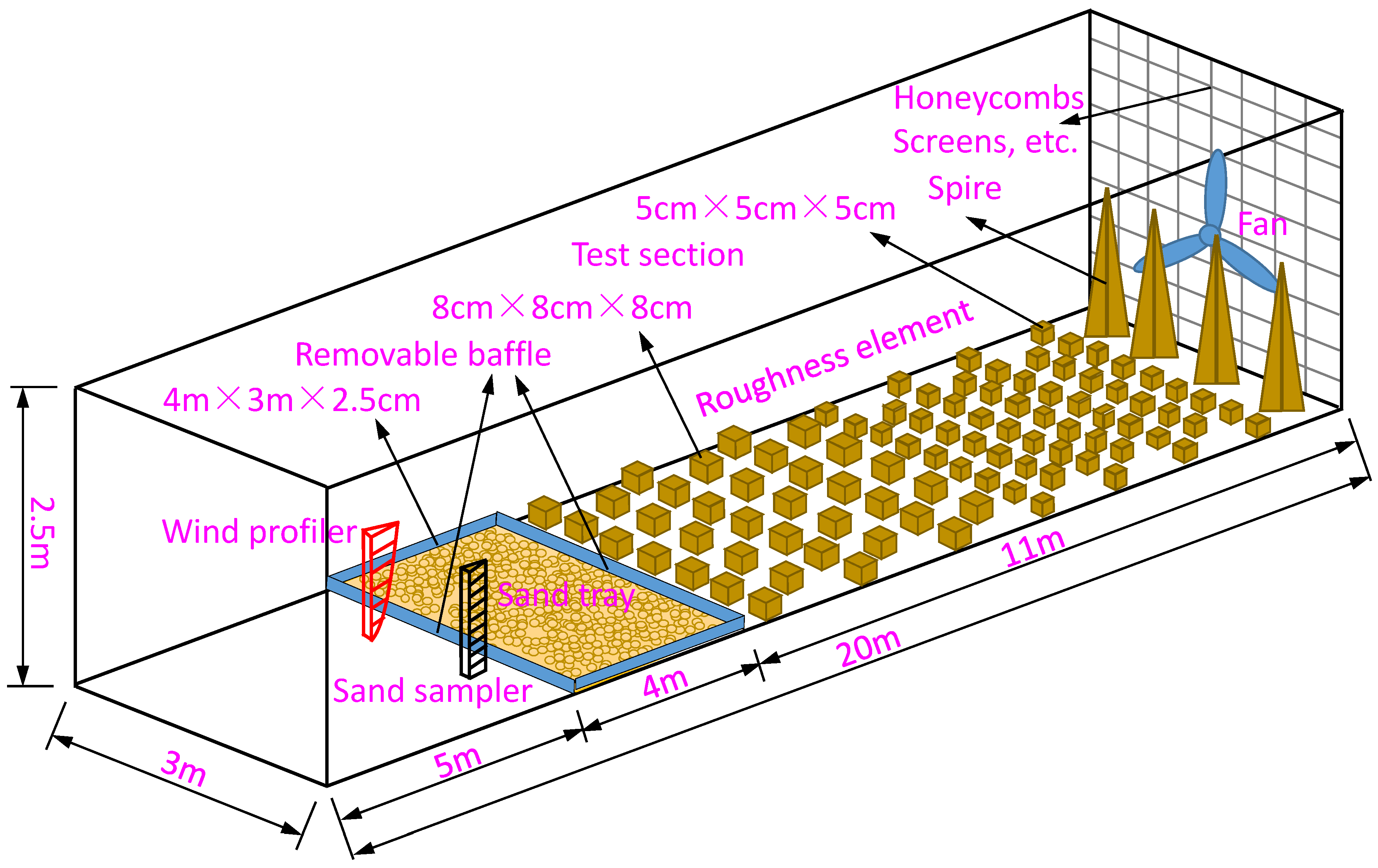
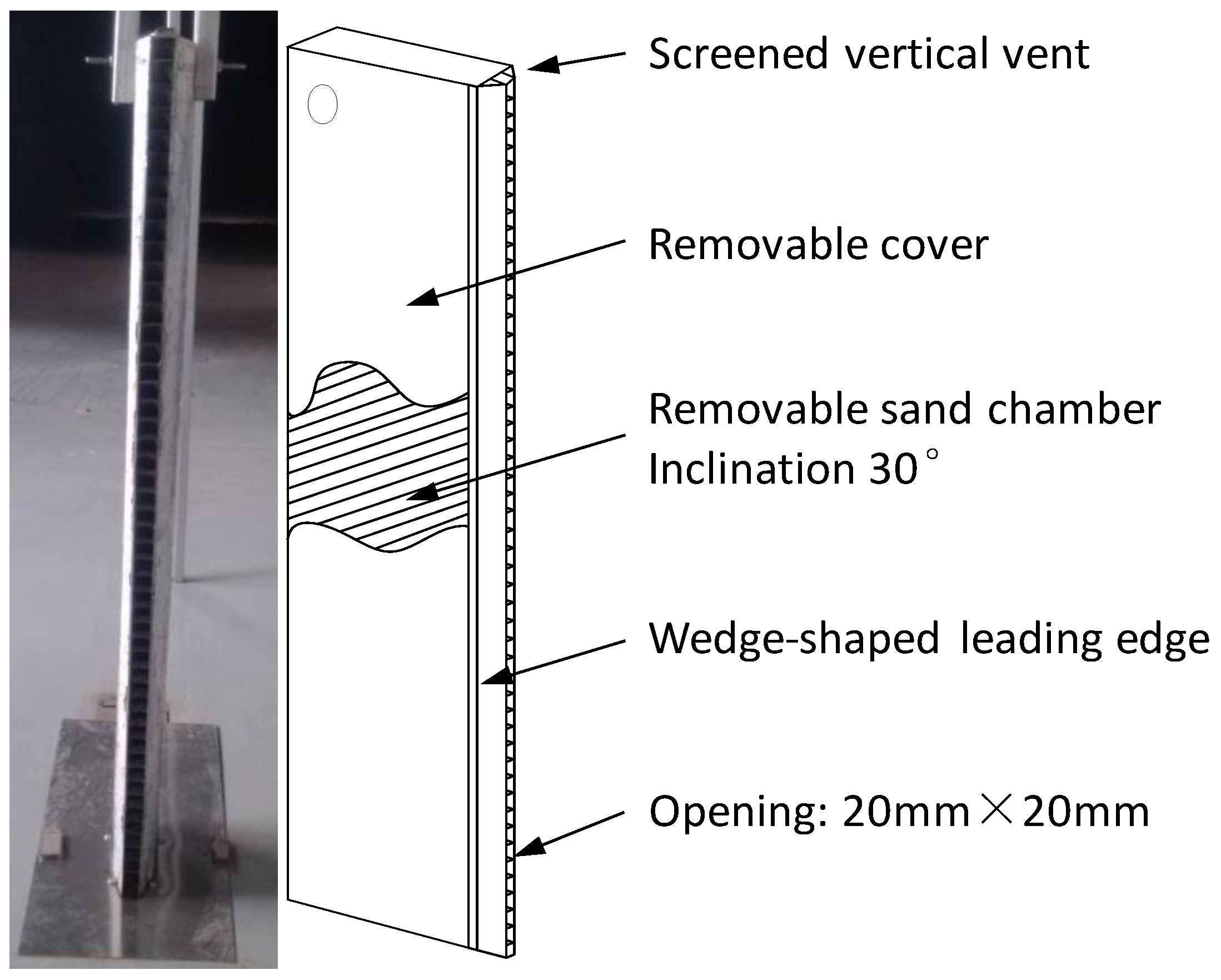
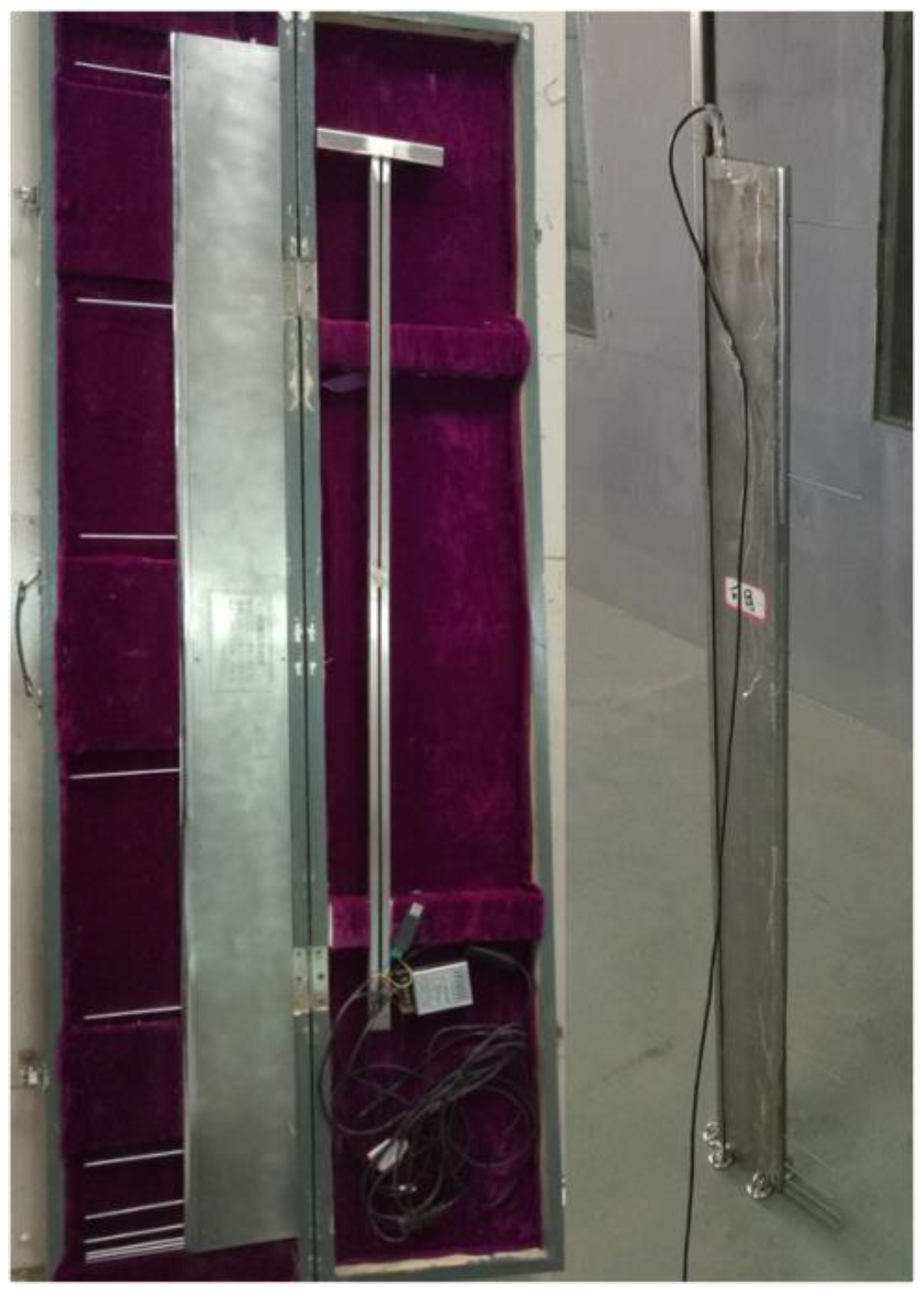
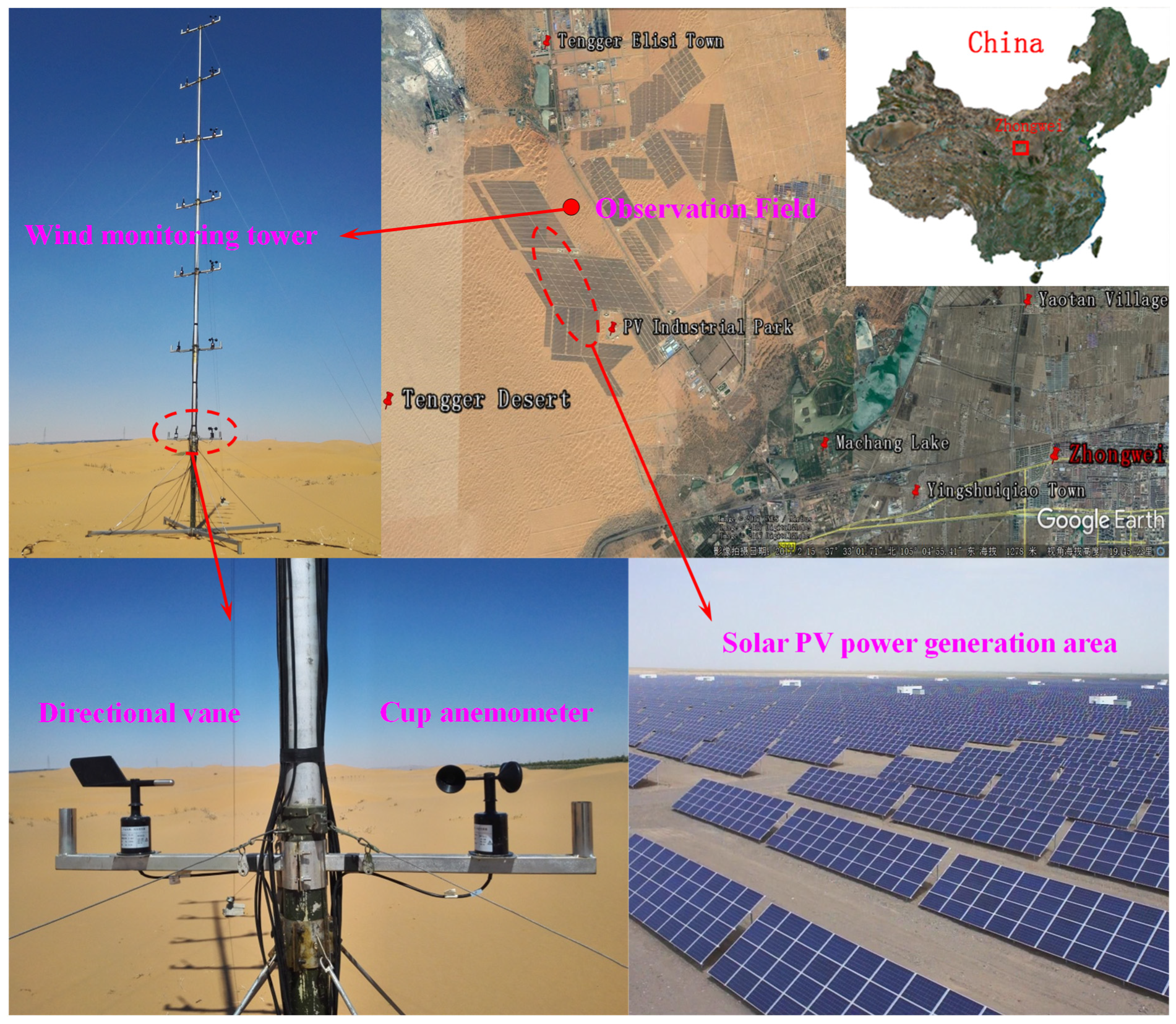
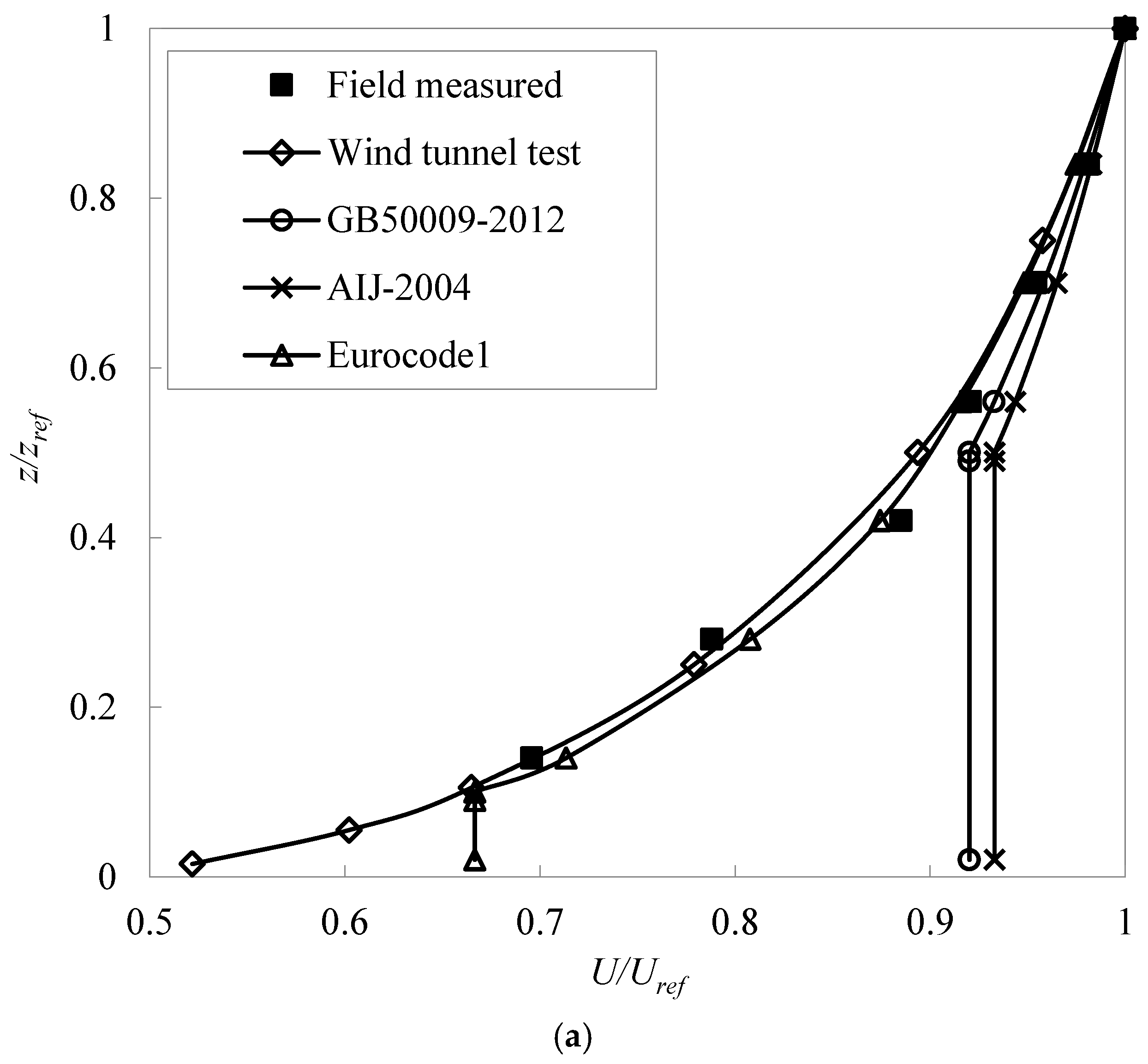
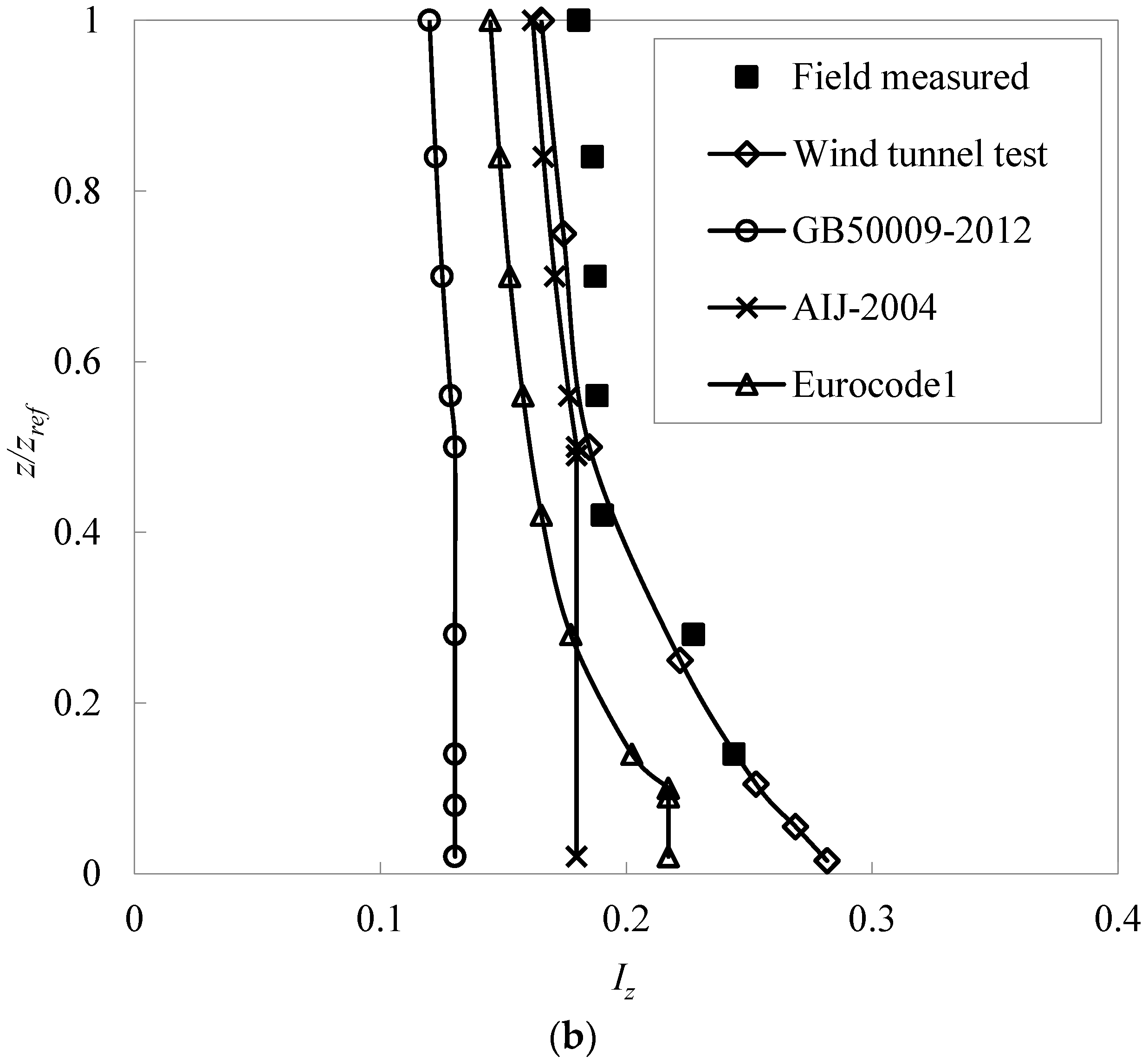
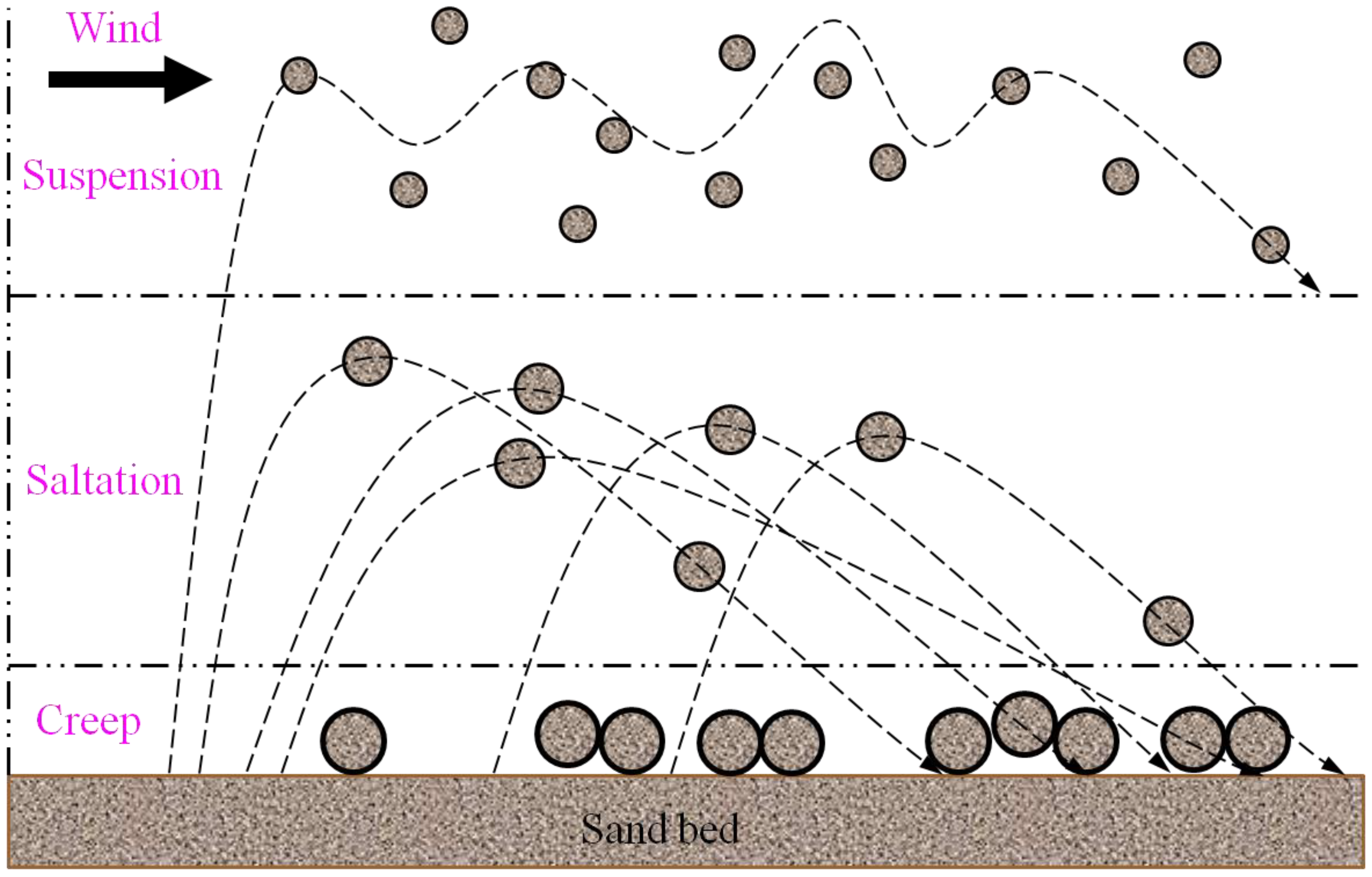
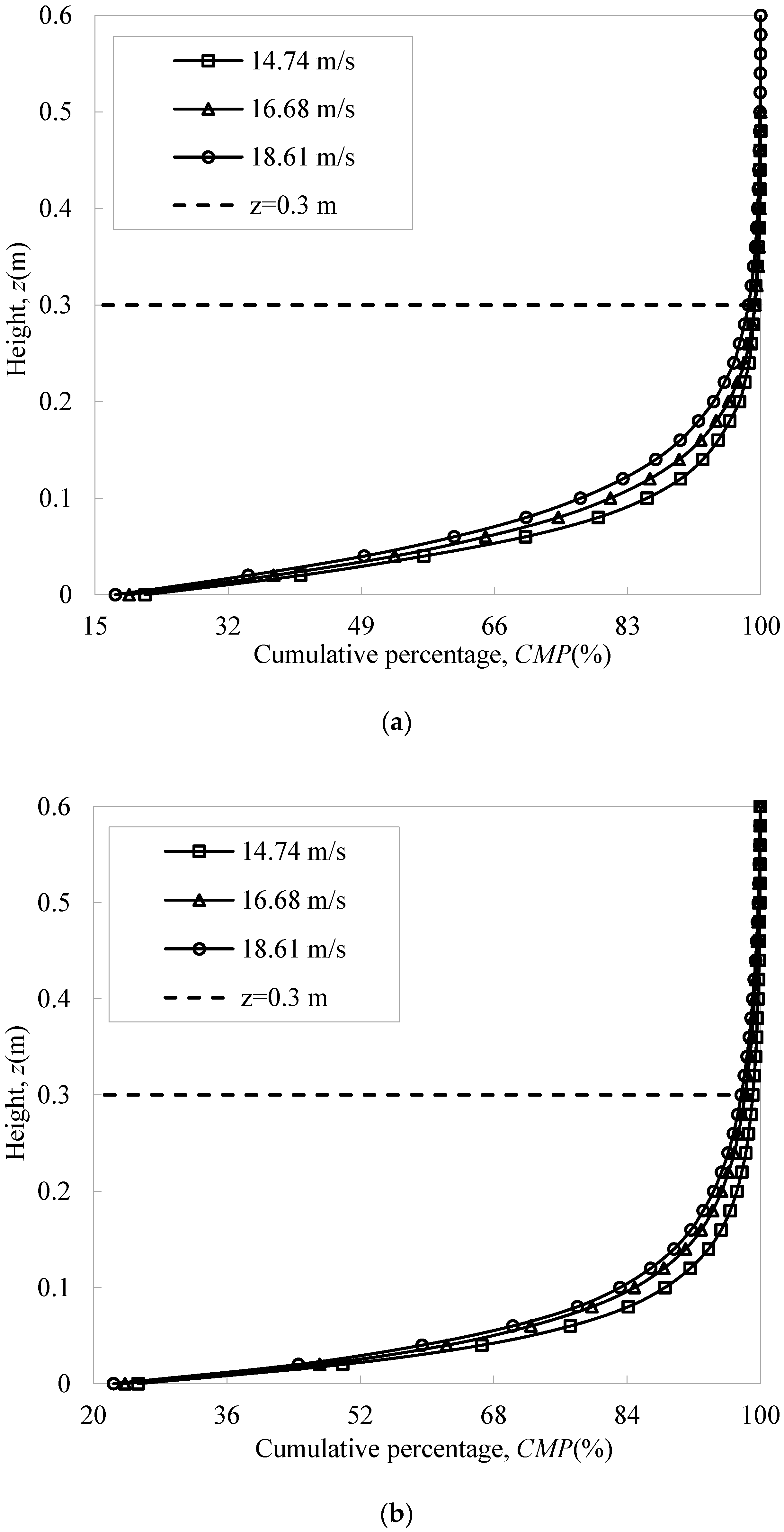
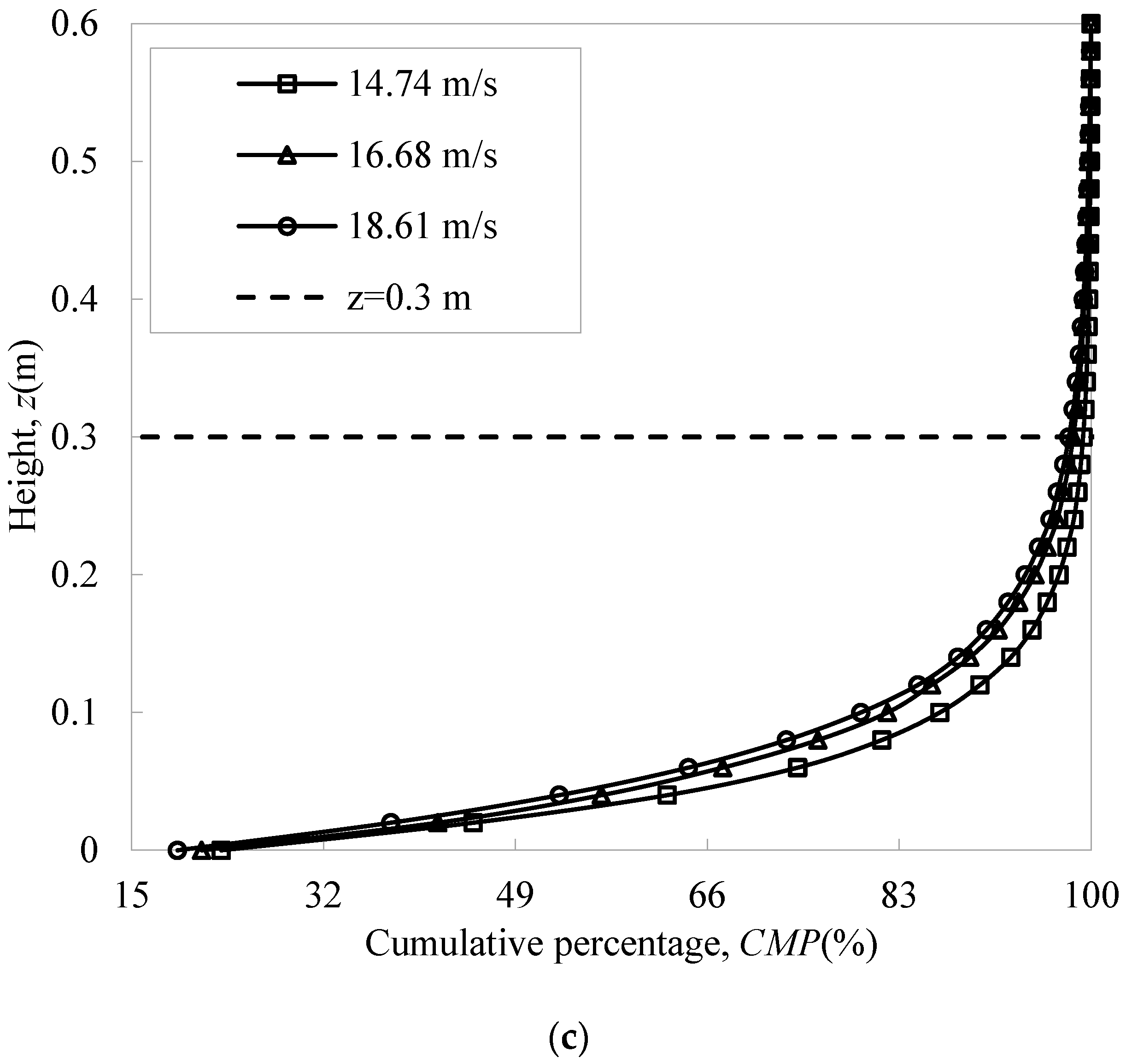
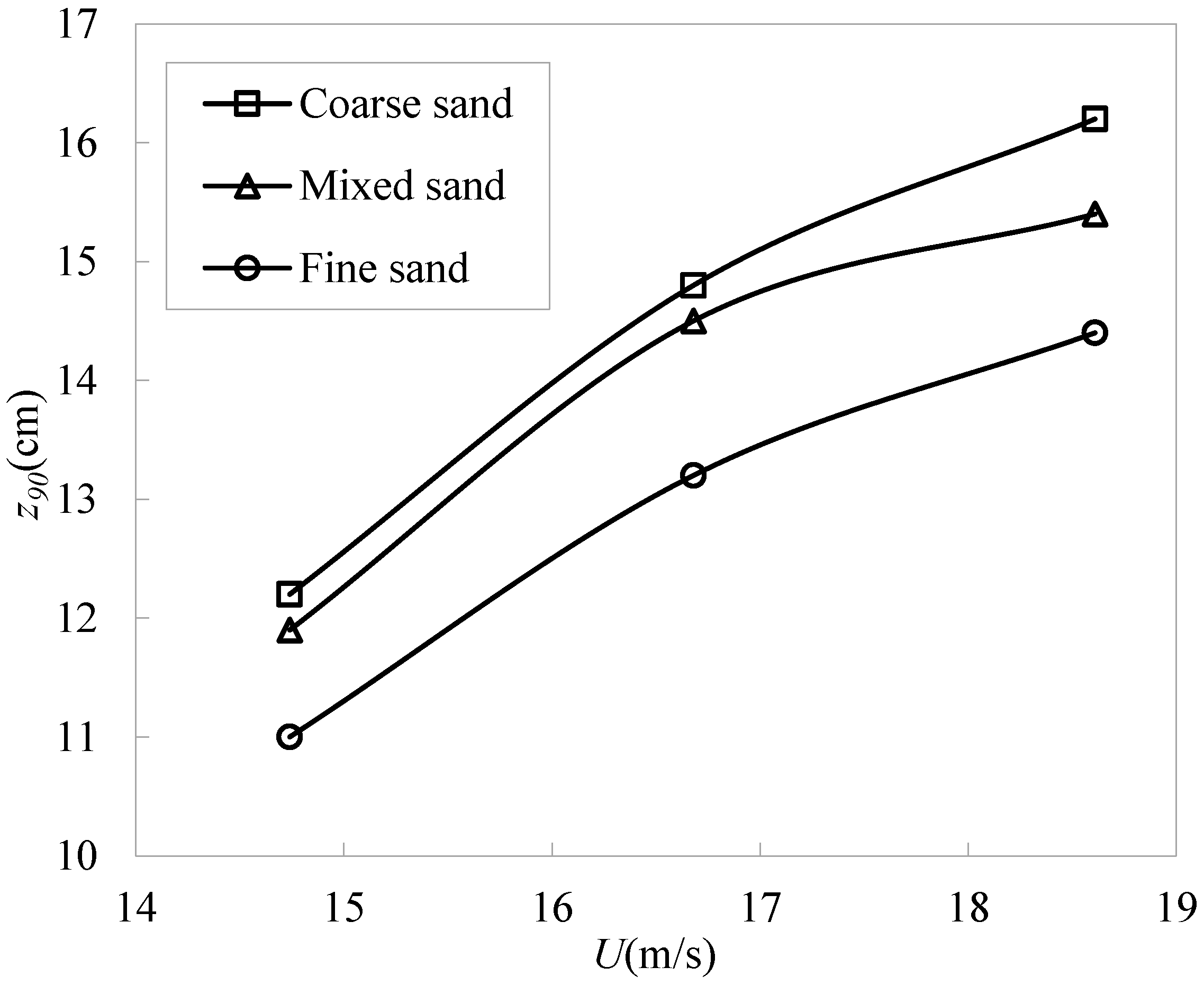
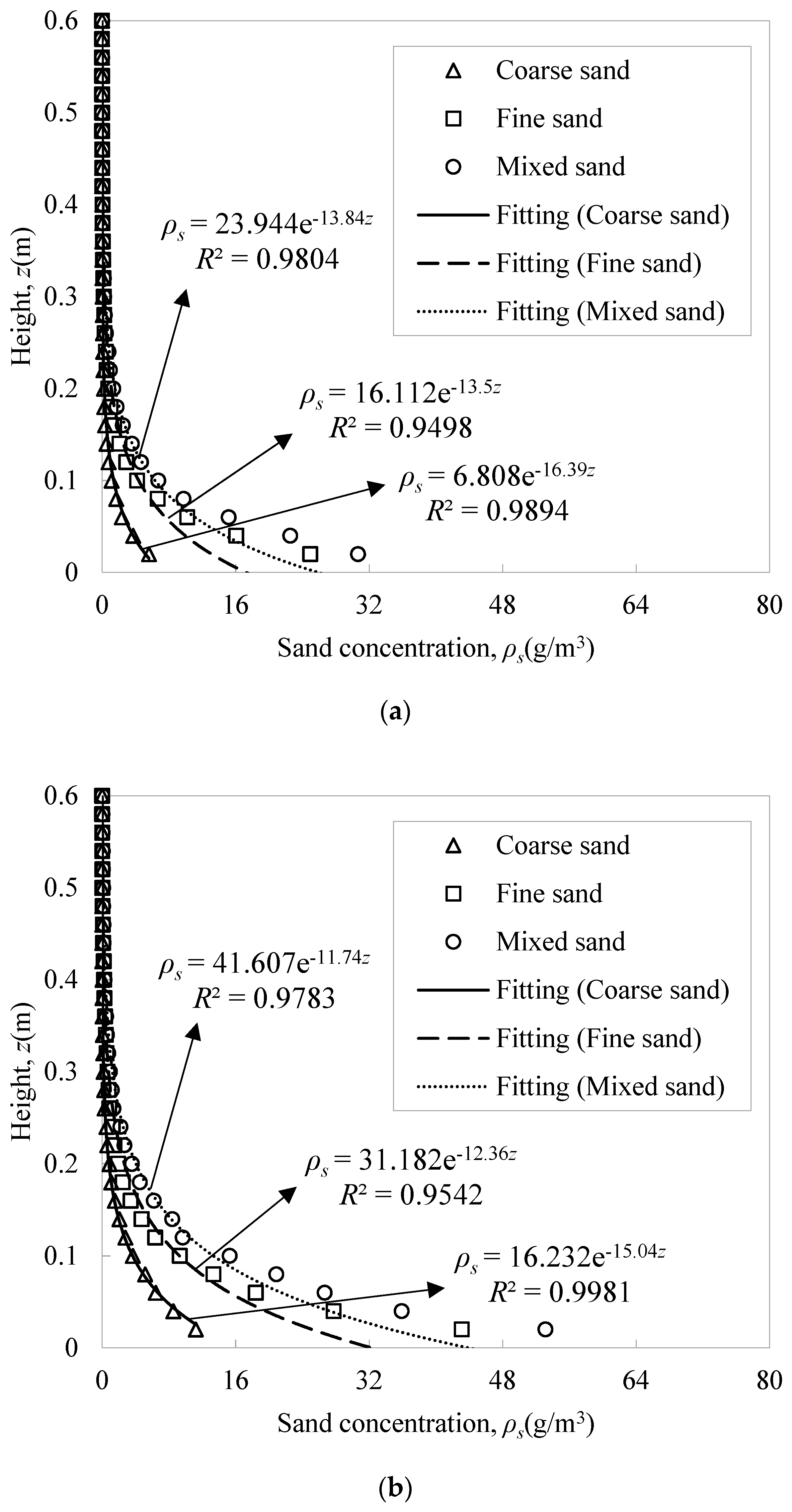
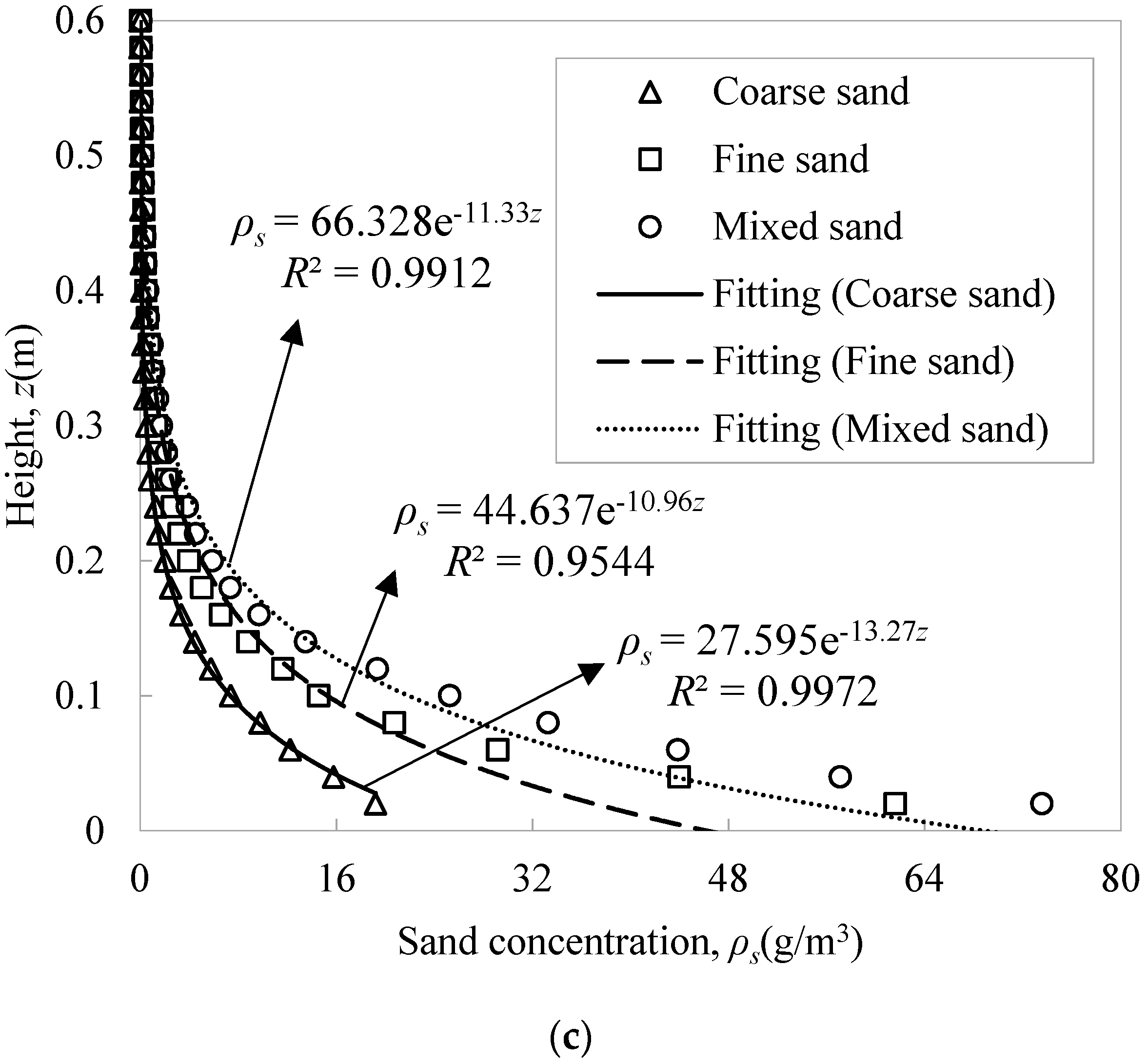

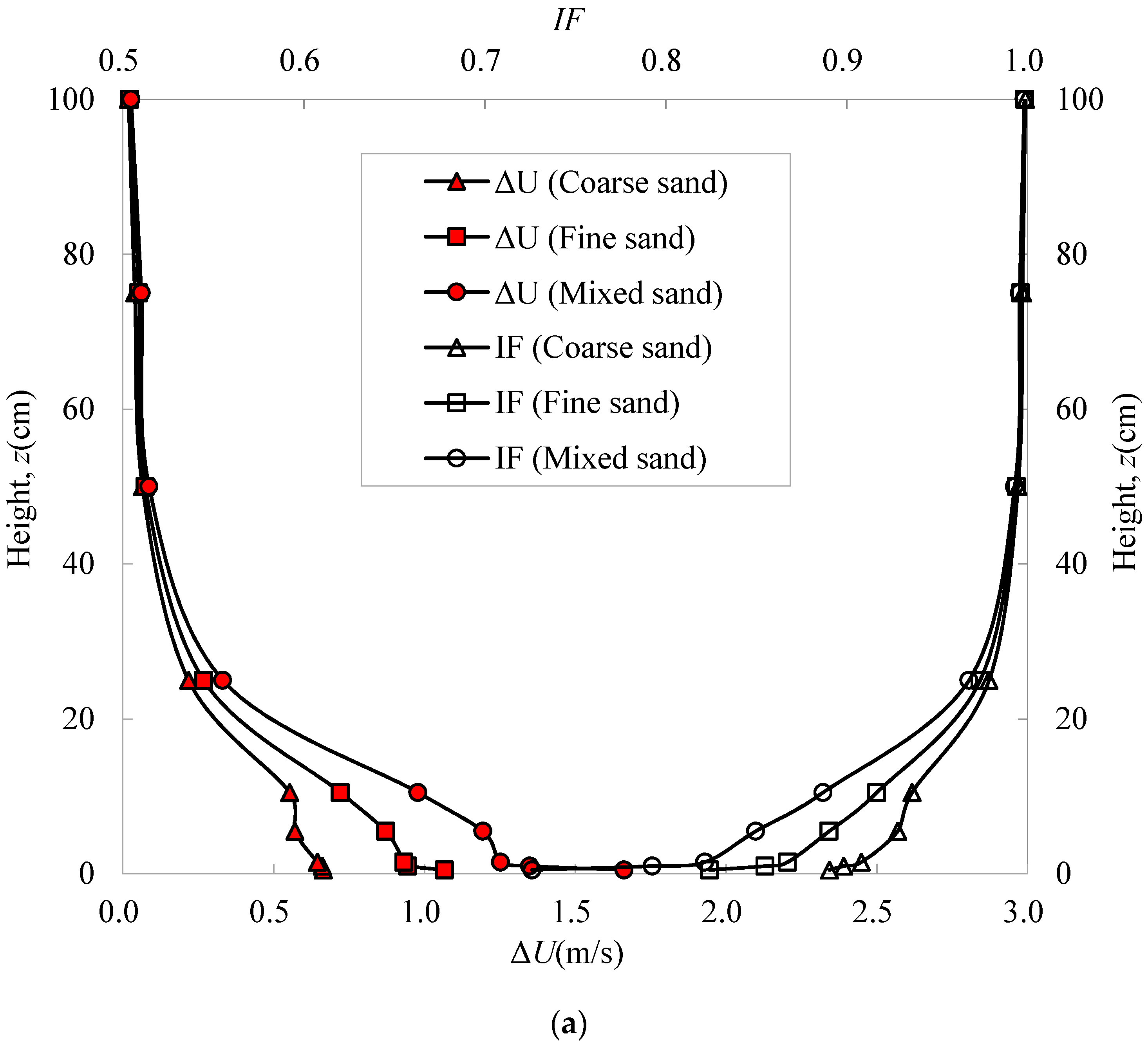
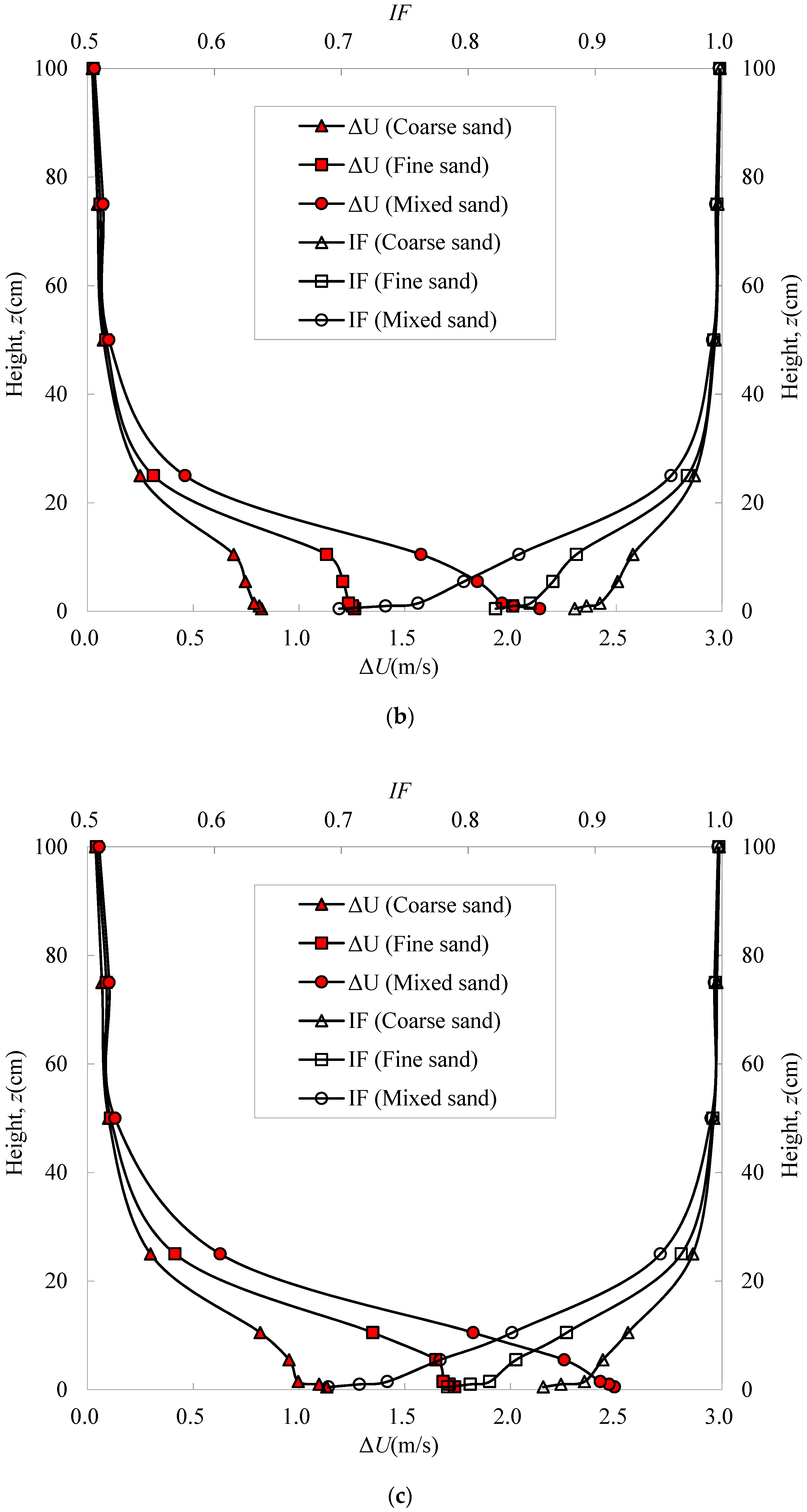
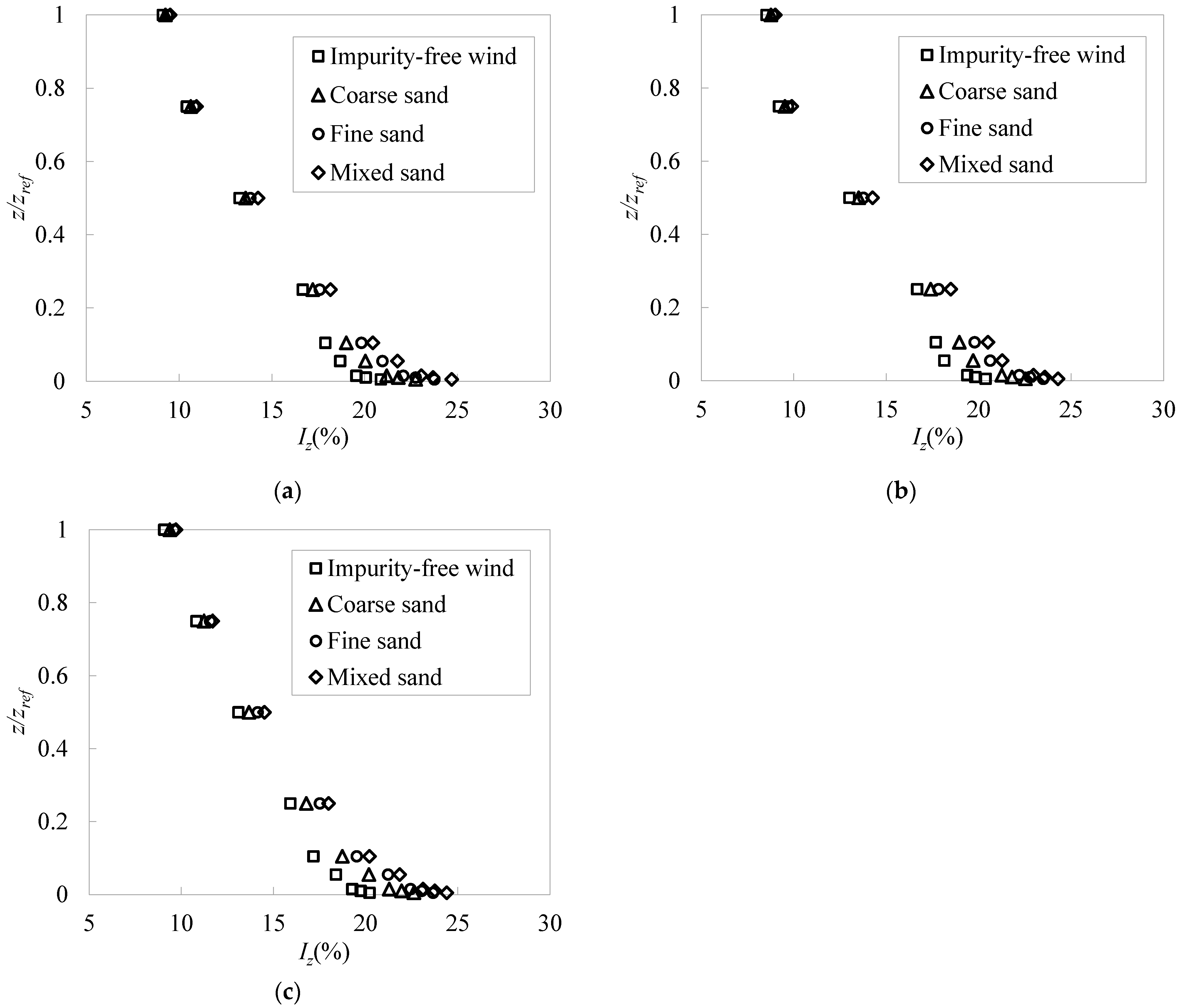

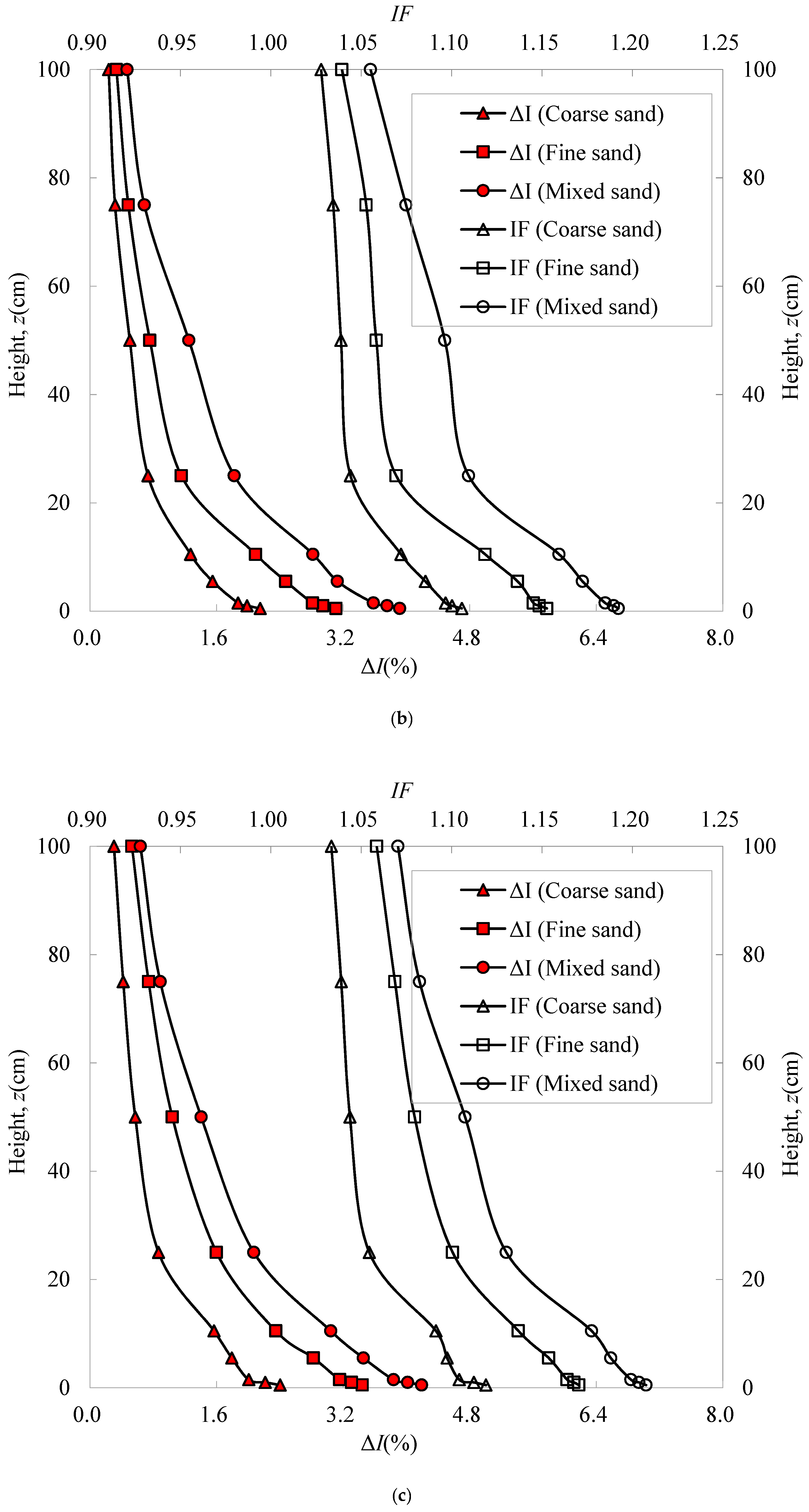
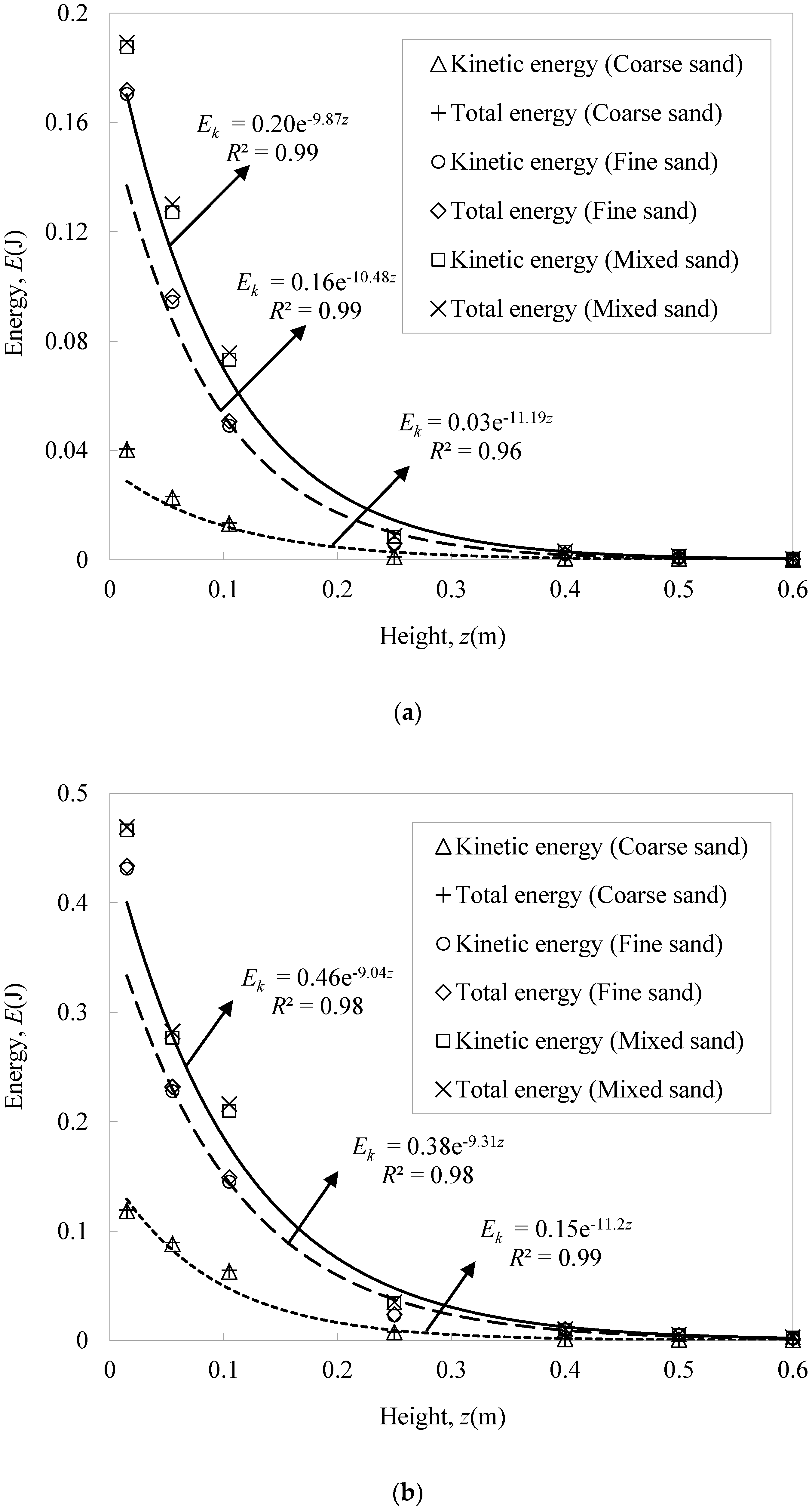

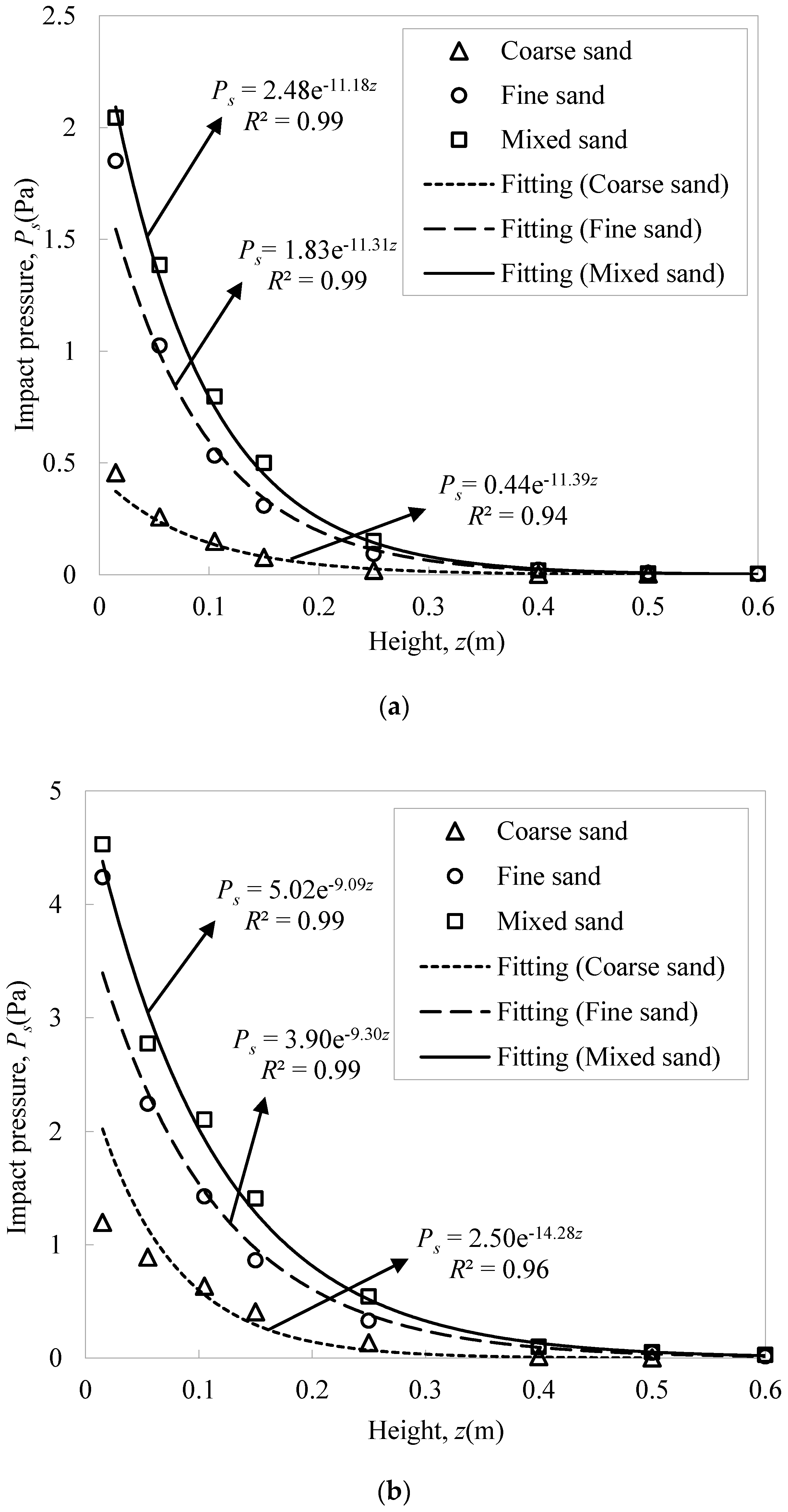

| Particle Size | Wind Speed (m/s) | 1Z90 (cm) | 2Fs (%) | Mean Fs (%) |
|---|---|---|---|---|
| Coarse sand | 14.74 | 12.2 | 0.8 | 1.0 |
| 16.68 | 14.8 | 0.7 | ||
| 18.61 | 16.2 | 1.6 | ||
| Mixed sand | 14.74 | 11.9 | 0.7 | 1.4 |
| 16.68 | 14.5 | 1.6 | ||
| 18.61 | 15.4 | 2.0 | ||
| Fine sand | 14.74 | 11.0 | 0.9 | 1.7 |
| 16.68 | 13.2 | 1.8 | ||
| 18.61 | 14.4 | 2.3 |
| Particle Size | Wind Speed (m/s) | ρs (In This Study) | q (In This Study) | q (Dong et al., 2002) | ||||
|---|---|---|---|---|---|---|---|---|
| a | 1/b | R2 | A | 1/B | A | 1/B | ||
| Coarse sand | 14.74 | 6.808 | 16.39 | 0.9894 | 0.0200 | 0.1639 | 0.0151 | 0.0305 |
| 16.68 | 16.232 | 15.04 | 0.9981 | 0.0535 | 0.1504 | 0.0501 | 0.0351 | |
| 18.61 | 27.595 | 13.27 | 0.9972 | 0.1020 | 0.1327 | 0.0784 | 0.0362 | |
| Mixed sand | 14.74 | 23.944 | 13.84 | 0.9804 | 0.0733 | 0.1384 | 0.1167 | 0.0632 |
| 16.68 | 41.607 | 11.74 | 0.9783 | 0.1384 | 0.1174 | 0.1896 | 0.0598 | |
| 18.61 | 66.328 | 11.33 | 0.9912 | 0.2428 | 0.1133 | 0.2740 | 0.0588 | |
| Fine sand | 14.74 | 16.112 | 13.50 | 0.9498 | 0.0495 | 0.1350 | 0.5009 | 0.1742 |
| 16.68 | 31.182 | 12.36 | 0.9542 | 0.1057 | 0.1236 | 0.8653 | 0.1706 | |
| 18.61 | 44.637 | 10.96 | 0.9544 | 0.1668 | 0.1096 | 1.2067 | 0.1499 | |
| Particle Size | Wind Speed (m/s) | m | n | R2 |
|---|---|---|---|---|
| Coarse sand | 14.74 | 0.03 | 11.19 | 0.96 |
| 16.68 | 0.15 | 11.20 | 0.99 | |
| 18.61 | 0.42 | 10.80 | 0.99 | |
| Fine sand | 14.74 | 0.16 | 10.48 | 0.99 |
| 16.68 | 0.38 | 9.31 | 0.98 | |
| 18.61 | 0.81 | 10.22 | 0.99 | |
| Mixed sand | 14.74 | 0.20 | 9.87 | 0.99 |
| 16.68 | 0.46 | 9.04 | 0.98 | |
| 18.61 | 0.95 | 8.73 | 0.99 |
| Particle Size | Wind Speed (m/s) | α | β | R2 |
|---|---|---|---|---|
| Coarse sand | 14.74 | 0.44 | 11.39 | 0.94 |
| 16.68 | 2.50 | 14.28 | 0.96 | |
| 18.61 | 4.39 | 10.94 | 0.99 | |
| Fine sand | 14.74 | 1.83 | 11.31 | 0.99 |
| 16.68 | 3.90 | 9.30 | 0.99 | |
| 18.61 | 7.73 | 10.26 | 0.99 | |
| Mixed sand | 14.74 | 2.48 | 11.18 | 0.99 |
| 16.68 | 5.02 | 9.09 | 0.99 | |
| 18.61 | 9.43 | 8.78 | 0.99 |
Publisher’s Note: MDPI stays neutral with regard to jurisdictional claims in published maps and institutional affiliations. |
© 2021 by the authors. Licensee MDPI, Basel, Switzerland. This article is an open access article distributed under the terms and conditions of the Creative Commons Attribution (CC BY) license (https://creativecommons.org/licenses/by/4.0/).
Share and Cite
Huang, B.; Li, Z.; Zhang, Z.; Zhao, Z.; Gong, B. Wind Tunnel Test on Windblown Sand Two-Phase Flow Characteristics in Arid Desert Regions. Appl. Sci. 2021, 11, 11349. https://doi.org/10.3390/app112311349
Huang B, Li Z, Zhang Z, Zhao Z, Gong B. Wind Tunnel Test on Windblown Sand Two-Phase Flow Characteristics in Arid Desert Regions. Applied Sciences. 2021; 11(23):11349. https://doi.org/10.3390/app112311349
Chicago/Turabian StyleHuang, Bin, Zhengnong Li, Zhitian Zhang, Zhefei Zhao, and Bo Gong. 2021. "Wind Tunnel Test on Windblown Sand Two-Phase Flow Characteristics in Arid Desert Regions" Applied Sciences 11, no. 23: 11349. https://doi.org/10.3390/app112311349
APA StyleHuang, B., Li, Z., Zhang, Z., Zhao, Z., & Gong, B. (2021). Wind Tunnel Test on Windblown Sand Two-Phase Flow Characteristics in Arid Desert Regions. Applied Sciences, 11(23), 11349. https://doi.org/10.3390/app112311349








